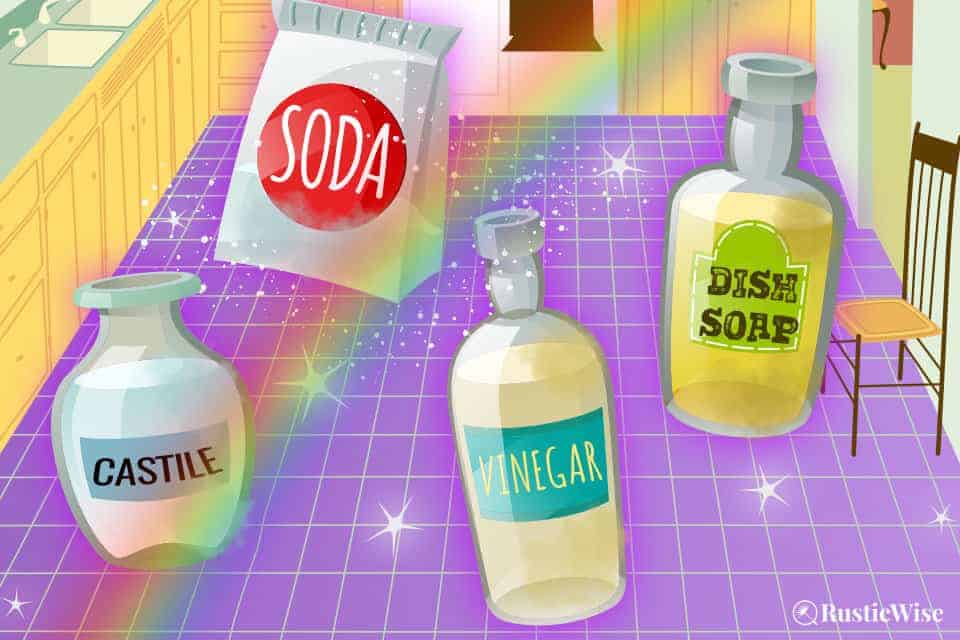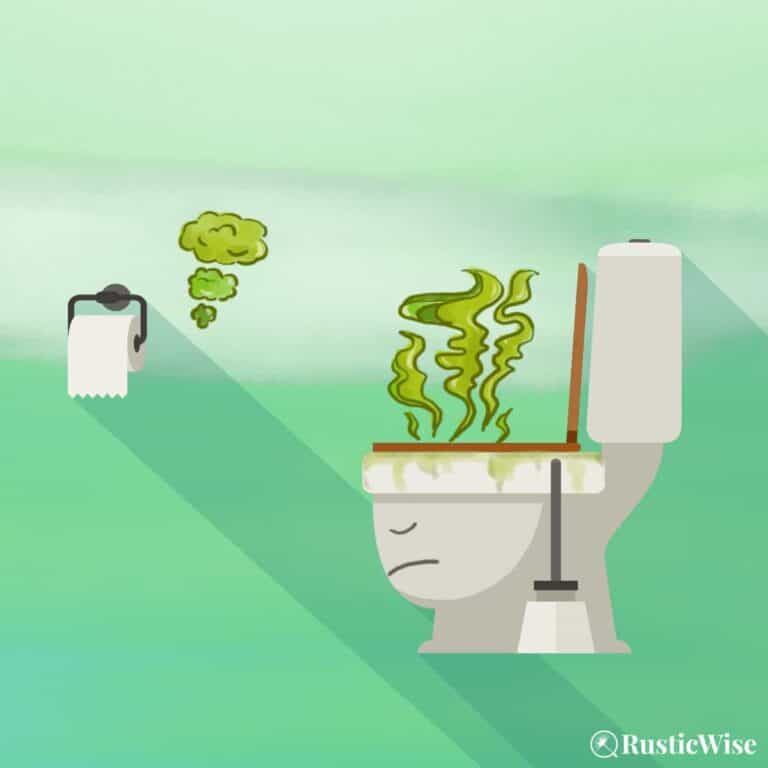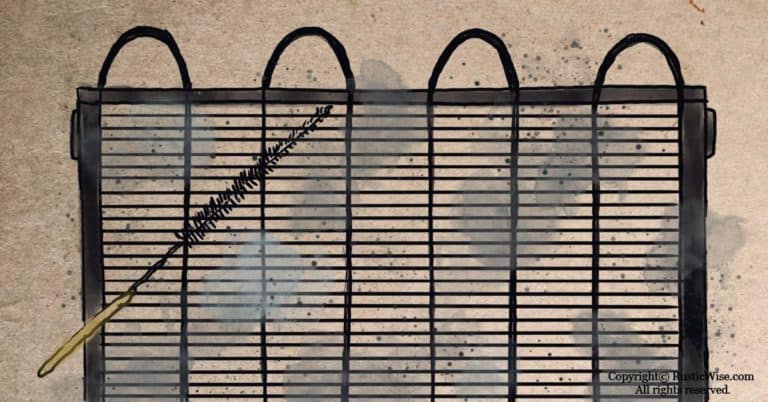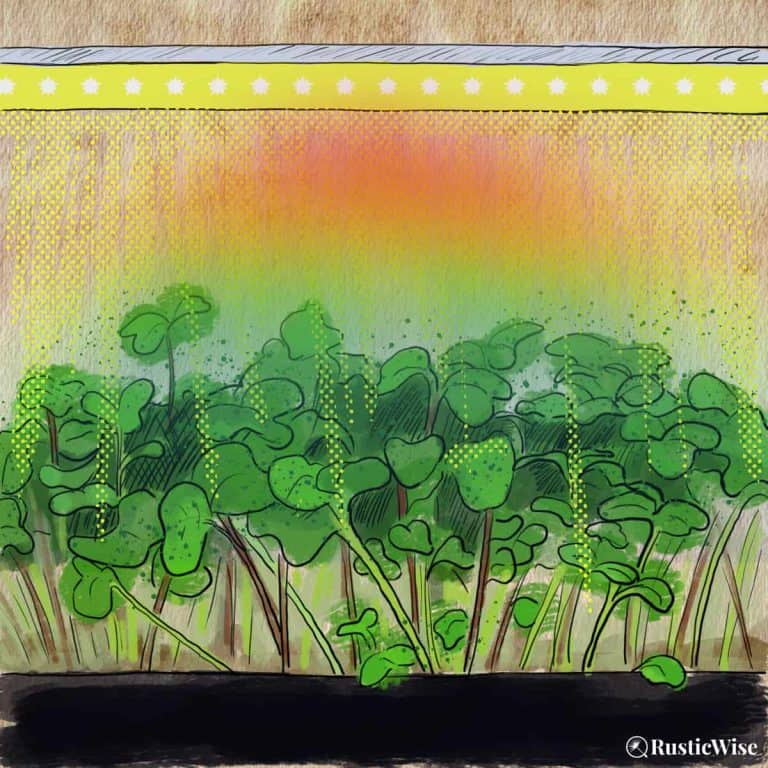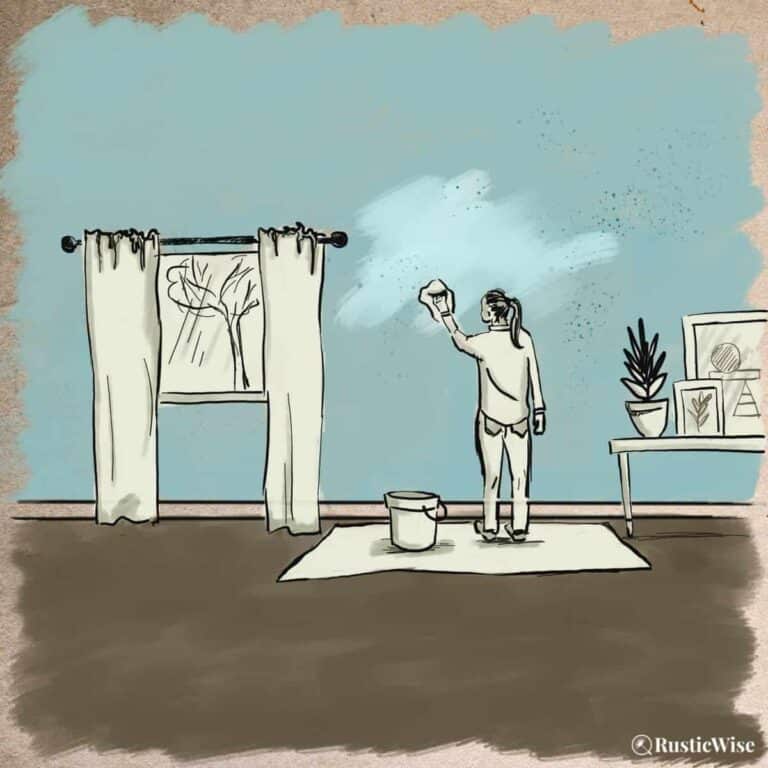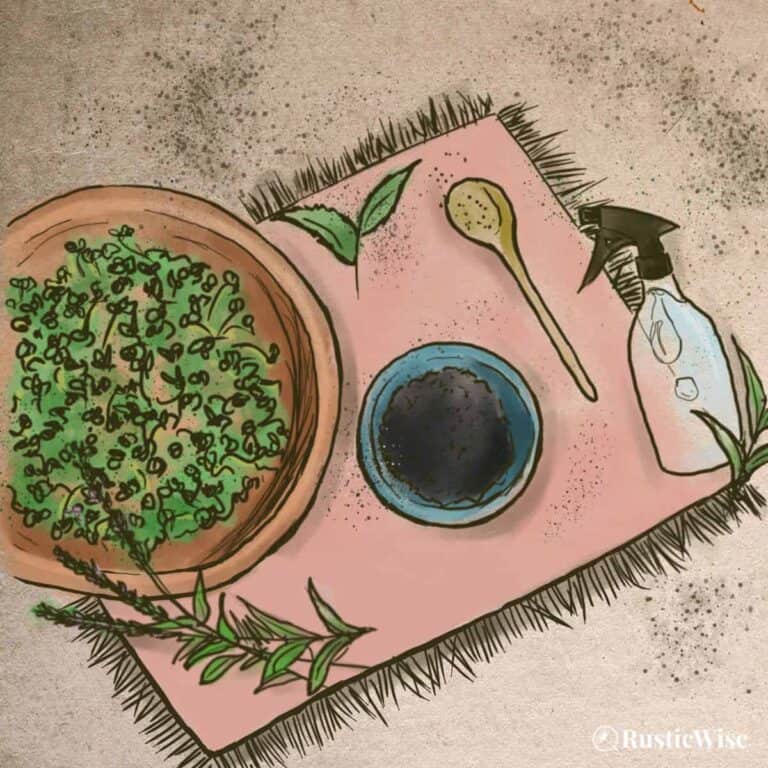Best Way To Clean Linoleum Flooring? Here Are 8 Handy Cleaning Tips
RusticWise is supported by its readers. When you purchase through links on our site, we may earn an affiliate commission. As an Amazon Associate, we earn from qualifying purchases. Thank You!
Durable, easy on the feet, and made of eco-friendly materials, linoleum flooring is fairly low-maintenance. While lino is easy to care for, don’t let cleaning fall to the wayside. With proper care, linoleum can last up to 40 years.¹
The best way to clean linoleum flooring is with daily sweeping or vacuuming to remove any dirt which can scratch the surface. Do a weekly mop using a mild cleaner, such as liquid dish soap, or a vinegar solution to keep flooring looking new.
While linoleum is water-resistant, it’s still susceptible to water damage. Let’s take a closer look at how to clean lino and care for it step by step. I’ll also share 8 handy cleaning tips. If you have black scuff marks on your floor, I’ll show you how to get rid of them!
What exactly is linoleum flooring?
Linoleum is a type of eco-friendly, smooth floor covering that’s composed of a mixture of oxidized linseed oil, flax, cork, wood components, and other pigments. The materials are pressed between industrial rollers and applied with a canvas or felt backing.²
Frederick Walton, the inventor of linoleum, accidentally left open a container of linseed oil one day. He noticed that a thick coating had developed on top of the oil, which lit the spark for his innovation. In 1860, Walton applied for a patent for this new flooring. It combines the Latin word linum (meaning flax) and oleum (meaning oil).²
This is a very resilient flooring that offers a “warmth” that is not prone to temperature fluctuations (unlike ceramic tile, for example). According to Britannica, the hardened surface makes it less prone to indents from heavy furniture, and is fairly resistant to the usual suspects that can damage floors including fat, oil, grease, and other organic substances.³
Here’s the kicker—lino doesn’t hold up well to excess moisture. The surface can also become damaged from strong alkaline cleaners such as ammonia or bleach.³
Don’t confuse lino with vinyl flooring
These two types of flooring are easily confused. While lino comprises mostly natural and biodegradable materials, vinyl contains vinyl resins and other plastics.
Vinyl comes in two main forms: luxury vinyl tiles (LVT), or vinyl roll flooring. It’s more waterproof and resistant to stains and scuffs. Linoleum on the other hand needs a bit more TLC—treat it as you would hardwood flooring.
So, how can you tell the difference between lino and vinyl?
Generally, linoleum comes in large sheets or squares. You may notice more seams across the entire floor. Lino is also prone to yellowing with regular sun exposure (although newer makes of lino flooring are more resistant to yellowing).
Vinyl, on the other hand, comes either in one large continuous roll, or as individual planks.
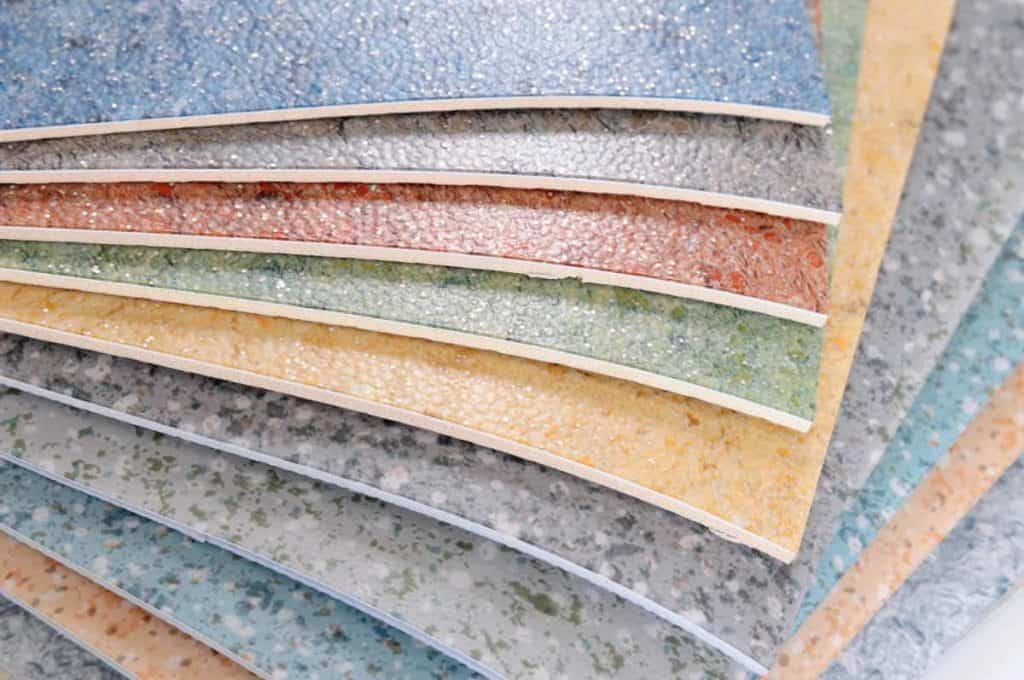
Credit: Vector State
8 linoleum cleaning tips
With regular cleaning and maintenance, linoleum is one of the most durable flooring materials. You may never need to change your flooring again!
Here are a few tips to keep your lino looking lustrous.
- Wring it out: As mentioned earlier, this type of flooring doesn’t like excess moisture. So, wring out that mop or cleaning cloth before cleaning your floor.
- Go easy around seams and edges: Take care to avoid using too much water around any seams and edges. Too much water may loosen the flooring with time, or encourage mold or mildew growth.
- Avoid high-pH cleaners: To preserve the finish on linoleum, skip the strong alkaline cleaners like ammonia and bleach. While a cup of ammonia may seem like a good way to break down grime and dirt, stay clear of strong alkaline cleaners. Ditto for bleach, another household cleaner with a high pH. Strong chemical cleaners will damage the surface.
- Avoid strong abrasive cleaning tools: Avoid scratching the finish with coarse cleaning abrasives, such as steel wool pads or metal brushes.
- Sweep or vacuum daily (or every few days): Give flooring a daily sweep or quick vacuum to remove dirt, dust, and loose debris which can scratch floors.
- Protect from scratches: One of the major culprits of scratches and scuffs is dining chairs, which are frequently dragged back and forth. Protect your flooring from scratches by putting chair protector pads onto all seating.
- Stick with natural rugs: Many types of natural flooring, including cork and linoleum, don’t jive well with rubber or latex-lined rugs. Stick with natural fibers instead.
- Prevent yellowing: You might recall seeing your grandmother’s lino floor marked with areas of discolored circles or squares from previous furniture arrangements. Luckily, newer lino doesn’t yellow as easily. But it’s still a good idea to protect floors from direct sun exposure (through filtered blinds) and periodically re-arrange the furniture to avoid tell-tale floor marks.
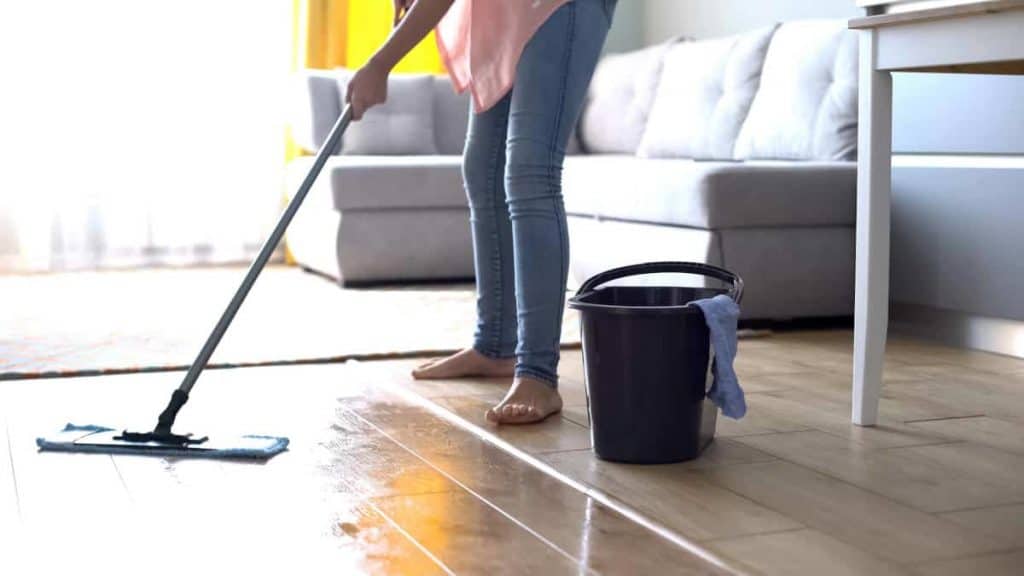
4 types of cleaners to remove dirt and clean linoleum flooring
The best way to clean linoleum flooring is to use a gentle cleaner with neutral (or close to neutral) pH levels. Here are a few good choices—choose one of the following:
1. Regular dishwashing soap
Something that everyone has at home is liquid soap for handwashing dishes, such as Dawn dish soap (or any other brand).
Dish soap is great for removing built-up grime and grease, and lifting dirt.
To make a dish soap solution, fill a bucket with 1 gallon of lukewarm water and 1/4 cup of mild dish soap.
2. Liquid Castile soap
For a more natural clean, try using liquid Castile soap such as Dr. Bronner’s. This biodegradable and plant-based cleaner works much the same way as regular dish soap to break down organic matter and remove dirt and grease.
To make a Castile soapy solution, fill a bucket with 1 gallon of lukewarm water and 1/2 cup of liquid Castile soap. Optional: add 10 drops of essential oil. (Some types of essential oil have antibacterial properties including tea tree, lemon, orange, and lavender essential oil.)
3. White vinegar
The type of vinegar you need to clean linoleum floors is simple white distilled vinegar. (You can save your fancy apple cider vinegar for other DIY projects.)
According to Kansas State University, vinegar is a great option to remove grease particles. As a natural mild acidic cleaner, vinegar works to gently disinfect and cut through grease, and remove sticky residue.⁴
To make a vinegar solution, fill a bucket with 1 gallon of lukewarm water and 1/4 cup of white vinegar.
4. A commercial mild floor cleaner
There are many commercial linoleum floor cleaners, or multi-purpose floor cleaners on the market—ensure you avoid ammonia-based cleaners. Try to pick one free of harsh chemicals which may be too abrasive for this natural flooring.
According to the American Cleaning Institute (ACI), select a “nonabrasive, all purpose cleaner” and dilute with warm water according to instructions. ACI notes that there are cleaners that simply clean, others that clean and shine, and others that simply add shine.⁵
You could try Mrs. Meyer’s Multi-Surface Cleaner or Method All Floor Cleaner (Squrit + Mop).
Best way to clean linoleum flooring: step by step
Do this process once a week to maintain your flooring. Roll up your sleeves and let’s begin!
Choose your cleaning solution (see above) and prepare the dilution according to directions.
Supplies you’ll need:
- Cleaning solution (see above)
- Large bucket
- Clean water
- Vacuum, or broom, or microfiber mop for step 1
- Wet mop, or microfiber mop, or several cleaning cloths for step 2
- Dry lint-free cleaning towels
Tip: Kansas State University recommends adding a capful of baby oil to the mop water to promote the floor’s lustrous shine.⁴
Step 1: Vacuum, sweep or dry mop
The first step to clean linoleum floors is to give the entire surface a quick dry vacuum, sweep, or dry mop to remove loose debris and dirt.
Step 2: Apply cleaning solution sparingly
Dip your wet mop or cleaning cloth into a prepared cleaning solution. Wring out to remove excess moisture.
Working in small sections of flooring, mop with the cleaning solution. It’s best to work in small squares or sections of floor to prevent excess moisture from sitting on the linoleum.
Step 3: Dry the flooring section
Once you’ve cleaned a small portion of the flooring, wipe floors dry with old lint-free towels or microfiber cloths.
Repeat steps 2 and 3 until the entire floor is clean. Change the cleaning solution as needed.
Step 4: Rinse cleaning solution with clean water
After the whole floor is clean, fill a large bucket with clean, lukewarm water. Thoroughly rinse your mop to remove any soapy residue.
Dip your cleaning mop into the bucket of clean water. Wring out excess water. Apply the clean water in small sections, just as before.
Step 5: Do a final dry
Dry each section as you go along. Once the entire floor has been rinsed, take time to thoroughly dry the entire floor, concentrating on seams and floor edges.
You’re done!
How to remove black scuff marks and other stubborn stains
Baking soda (aka sodium bicarbonate) is a natural mineral salt and gentle abrasive. It works to brighten and lift stains.
To remove black scuff marks and other troublesome stains, make a baking soda paste. Add a few tablespoons of baking soda in a small bowl. Add just enough water to form a thick paste.
Apply the baking soda paste using a sponge or nylon-bristled cleaning brush to scrub out any stuck-on grime and dirt.
Tip: For a deep clean of linoleum flooring, follow the wet mop instructions above, and apply a baking soda paste where needed to remove scuffs and stains.
Related questions
Does vinegar ruin linoleum flooring?
No, white distilled vinegar is safe to use on linoleum floors. Most bottles of vinegar contain roughly 5 percent acetic acid, making it a mild acidic cleaning agent. When diluted with water, vinegar works well to lift dirt and gently clean.
How do you clean old linoleum with ground dirt?
Dampen a soft-bristled nylon cleaning brush with clean water. Sprinkle a bit of baking soda directly onto the soiled flooring. Working in small circles, gently scrub until all dirt is removed. Follow up up wiping clean with a damp cloth. Finish by wiping dry with a microfiber cloth.
Can you use bleach on linoleum floors?
No, stay clear of bleach and other high-pH household cleaners on linoleum flooring. Bleach is highly abrasive and is a strong alkaline cleaner which may damage the protective finish.
Would you like more timeless tips via email?
Fun tips to help you live an independent, self-sustaining lifestyle. Opt-out at any time.


References
- Orentas, Geraldine and Allen, Samantha (10 February 2022). “The Pros And Cons Of Linoleum Flooring,” Forbes. Accessed June 2022.
- Hagley Museum and Library, The Evolution of Linoleum, https://www.hagley.org/librarynews/evolution-linoleum. Accessed June 2022.
- Britannica, Linoleum flooring, https://www.britannica.com/technology/linoleum. Accessed June 2022.
- Kansas State University (Johnson County), Homemade Cleaners, https://www.johnson.k-state.edu/docs/home-family/Homemade%20Cleaners.pdf. Accessed June 2022.
- The American Cleaning Institute, Cleaning Hard Surfaces (Resilient Flooring) https://www.cleaninginstitute.org/cleaning-tips/cleaning-hard-surfaces. Accessed June 2022.

Author: Josh Tesolin
Josh is co-founder of RusticWise. When he’s not tinkering in the garden, or fixing something around the house, you can find him working on a vast array of random side projects.

